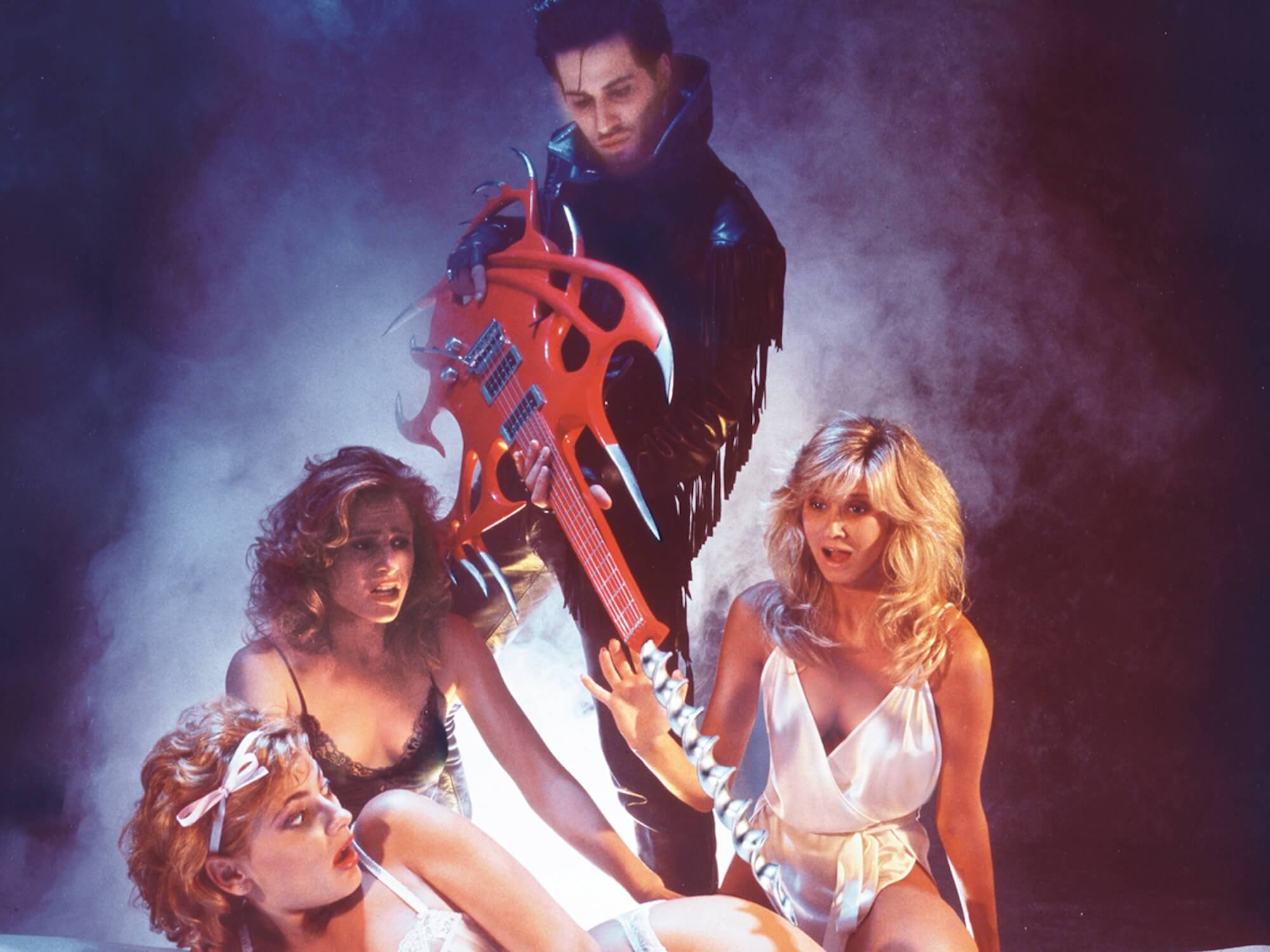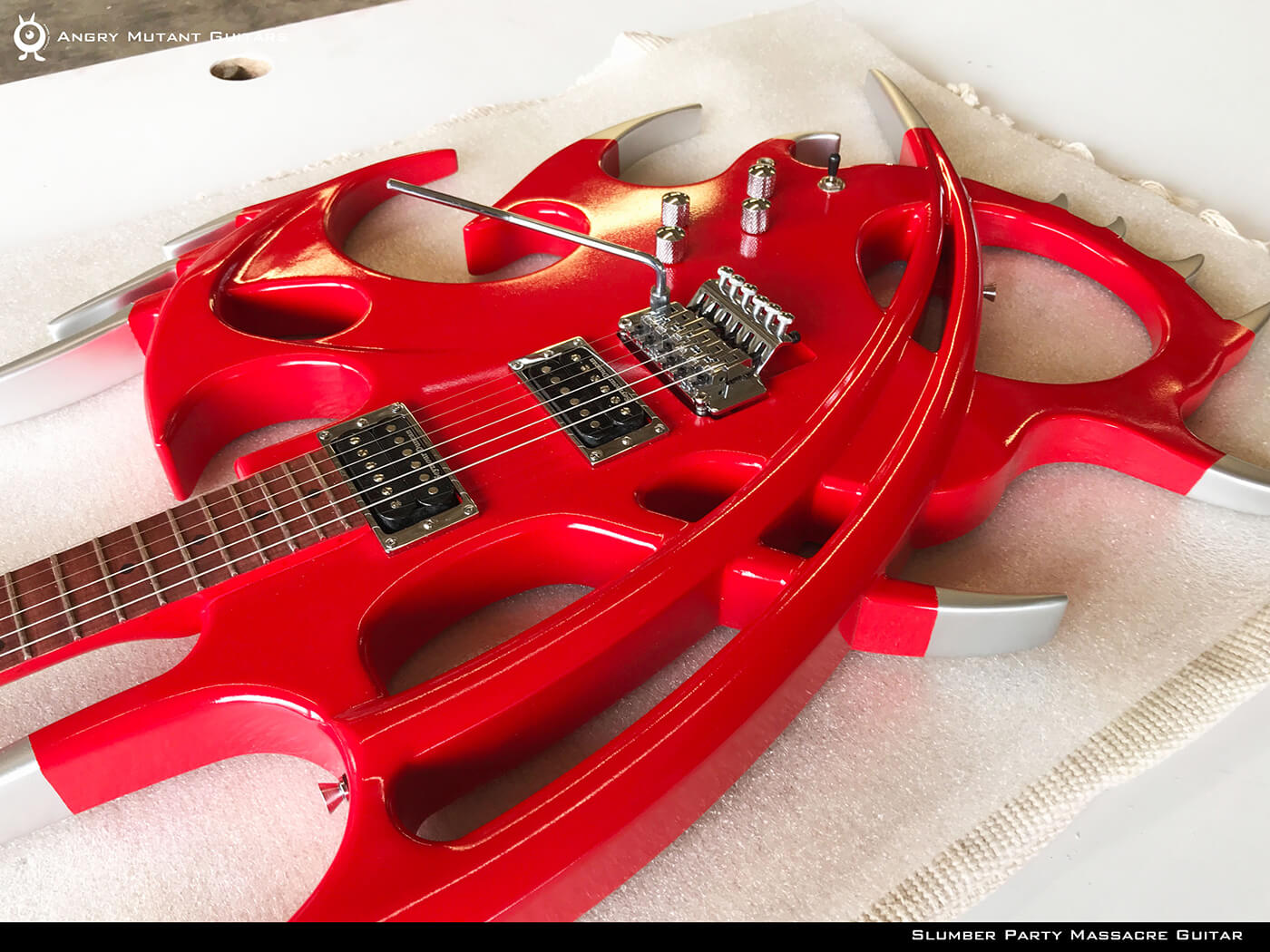Related Tags
Guitar On Film: Halloween Special – the story of Slumber Party Massacre II’s drill bit guitar
Our history of the weird and wonderful guitars of the silver screen takes a spooky detour into an 80s cult slasher movie, a bizarre one-off guitar, and the modern engineer trying to replicate it.

The drillbit guitar became the focal point of the movie marketing, as the film’s promotional poster demonstrates. (Image Scream Factory/New Concorde)
Tune in, tune up and turn it up to 11! From arthouse gems and cult classics to teen blockbusters and beyond, Guitar On Film explores the stories of onscreen guitars and the people who play them
- READ MORE: Guitar On Film: Mad Max: Fury Road
Brian Williford doesn’t profess to be a luthier. So how is it that he can charge $5,000 for his custom-made guitars? Does he use industry-prized exotic tonewoods? No, they’re made from a slab of maple. Do they boast bleeding-edge electronics? Nah, a set of $60 humbuckers usually does the job. Is there a famous name on the headstock? Well, actually, there’s a 15-inch drill bit where the headstock should be. This isn’t just any six-string. Salt your popcorn, tune to drop-D and say hello to an icon of 1980s horror: the Slumber Party Massacre II guitar.
Released in 1987, Slumber Party Massacre II is a satirical slasher with a musical bent and a mean sense of humour. The sequel to 1982’s Slumber Party Massacre, it was written, produced and directed by Deborah Brock under the stewardship of legendary producer Roger Corman. The film follows a group of high-school seniors who are tormented by the maniacal “Driller Killer”. So far so slasher. But while it’s not unusual for slasher villains to wield an axe, theirs don’t usually have strings.
Played by Atanas Ilitch (the heir to a Detroit sports-entertainment empire), the movie’s villain is a crazed greaser – all hair, pelvis and leather – who speaks in rock lyrics. The character is the embodiment of musical machismo and needed a suitably phallic instrument to match.
“The idea,” Brock tells us over email, “was to visualise the violent sexuality of male rock ‘n’ roll and slasher films.” The guitar was in the script from the start. Based on a recommendation, Brock brought special effects designer James Cummins aboard to build it. Having worked with effects legend Stan Winston and on John Carpenter’s The Thing, which boasts some of the greatest practical effects of all time, Cummins certainly had pedigree. But he’d never built a guitar before.
“When he read the script, he loved the guitar-drill idea,” says Brock. “I think it’s why he wanted to do the film – and he had to do it for very little money because the film’s budget was tiny [$500,000].” Brock’s brief to Cummins? “It’s gotta be the coolest guitar you’ve ever seen and has a drill extending out of the neck.”
Cummins spent about five weeks designing and building the guitar. In fact, according to Brock, he built two: the hero, for close-ups and important shots, and a simpler, more lightweight model with a plastic drill, for stunts and wide shots. Neither was functional. Brocks says the guitar may have been made from fibreglass, and that in place of the hero’s electronics was a Makita drill that powered the enormous priapic auger.
This isn’t the only instrument in the film. Slumber Party Massacre II’s central characters make up a preppy four-piece band, whose members play Yamaha gear including SE series guitars. The actors do a solid job miming to songs that came courtesy of real Los Angeles group Wednesday Week. The driller killer’s riffs, meanwhile, were supplied by pro guitarist Rick Cox.
The original Slumber Party Massacre II guitar now resides with a private collector and, because Cummins passed away in 2010, there is much we may never know about its construction. Cummins was an effects expert, not a luthier. And neither is Brian Williford.
Williford is a carpenter and all-around craftsman. He is based in Virginia, in a former velveteen factory home to small independent companies including glassblowers, cabinetmakers and metalsmiths.
In 2018, Williford was approached by two film-makers who were staging a photoshoot based on Slumber Party Massacre II. “They were recasting the scenes with actors,” says Williford. “They asked us to make a prop guitar. It didn’t have to play. It just had to look like the one from the movie.”
Given that the Slumber Party Massacre II guitar looks like a limited-edition tribal tattoo-themed powertool, this was no easy task. Williford roughly traced the unique shape of the original and used a CNC machine to mill it from a single piece of plywood, neck and all. With some painted-on frets, mock pickups and an audacious auger affixed to the end of its neck, it was a commendable first effort.

Since then, Williford has built multiple versions of the guitar, each better than the last. His second model was a big step up. Williford installed two humbucking pickups, working electronics and handsome chrome hardware. But even with the new truss rod, between the Floyd Rose-style vibrato system and the weighty auger, the tension on the neck caused the custom-milled cherry fretboard to pop right off the neck. Every build is a learning process.
Still, Williford knew he was on to something: cult film fans are willing to part with serious sums to get their hands on movie memorabilia. The second build sold just days after it was listed on Etsy. Soon after, he was hired by a performance artist to build a third.
“Even though it was a prop,” he says. “I tried to make it playable, with real strings and real pickups. What I learnt – the hard way – was that because of the weight of the drill bit, there’s no way the neck can stay in tune. It’s like swinging a metal baseball bat.”

For the third model, rather than cutting the neck in one piece with the body, Williford used a modified (by which we mean decapitated) pre-bought neck. “I’ve tried it both ways,” he says. “The problem with making a thru-neck is that you’re responsible for all the fretting and the accuracy of the fretting, and filing it all. And I’m not a luthier. So the advantage of buying the neck is that it’s fretted fairly well, and the fretboard is nice. All you’re doing is adapting it.”
On later models, Williford made the auger detachable, so that the guitar remains playable and can hold its tuning . Then, when you want to, you can reattach the drill and put on a show.
Because there are so few high-quality movie stills to use as reference, Williford considers his builds an “interpretation” of the real deal, rather than an exact copy. He creates the shape by eye, using 3D modelling software that also directs the CNC machine. His first few builds were flat but, after that, Williford redrew his design to incorporate the overlapping points of the body. “I don’t have an original to compare it to,” he says. “They didn’t release any technical drawings or anything…”

Given the price of CNC technology in the 1980s, combined with Slumber Party Massacre II’s meagre budget, it’s unlikely that Cummins would have used CNC to build the original guitar. Williford speculates that it could’ve been made from epoxy resin, poured into a silicone mould fashioned from a clay negative, and then painted over.
We suggest that the original might have been made from fibreglass.
“Oh, fibreglass! I hadn’t considered that,” says Williford. “They could’ve sculpted the body in foam and then put fibreglass around it and treated it like an auto body. The old Corvettes back then were fibreglass.”
Guitar aficionados may scoff at Williford’s use of plywood or maple. But there should be no shame in making use of local materials rather than costly, scarce tonewoods. Makers have always used what was closest to them. In 1950s California, Leo Fender reportedly sourced ash from nearby furniture builders because it was inexpensive. Williford is doing the same thing. (Granted, Leo never fixed a drill to the end of a guitar’s neck.)
We may never know the specifics of the original Slumber Party Massacre II guitar. But however it was built, it’s clear to Williford that it wasn’t playable.
“I get into arguments with people where they’re like, ‘Well, the original in the movie played’. And I’m like, ‘Why do you think that?’. ‘Because I heard it.’ And I’m like, ‘When you see spaceships in Star Wars, does that mean spaceships are real? Just because the guy was doing this [mimics playing] and you hear a riff doesn’t mean that guitar was making that riff.’” Good miming and movie magic goes a long way.
Williford isn’t the only person to have replicated the Slumber Party Massacre II guitar over the years, and the DIY builds of horror enthusiasts can tell us much about how Cummins’ original may have been built.
As should be clear from these makers’ efforts, Slumber Party Massacre II lives on. The slasher has gained a cult following thanks to its feminist undercurrent and unusual story. The outrageous guitar probably helps too.
Williford says making each guitar is enormously time-consuming and not profitable. There’s even a tongue-in-cheek disclaimer on his website – “Be realistic that this [is] an offensively expensive piece of semi-functional art that replicates an unrealistic movie prop” – that almost dissuades customers from ordering one.
Even still, he wouldn’t mind doing one Slumber Party Massacre II guitar a year. A gift for the guitarist horror-lover in your life, perhaps? Get your orders in here soon; Christmas is coming.
Slumber Party Massacre I & II are available in remastered 4k format via Scream Factory.




